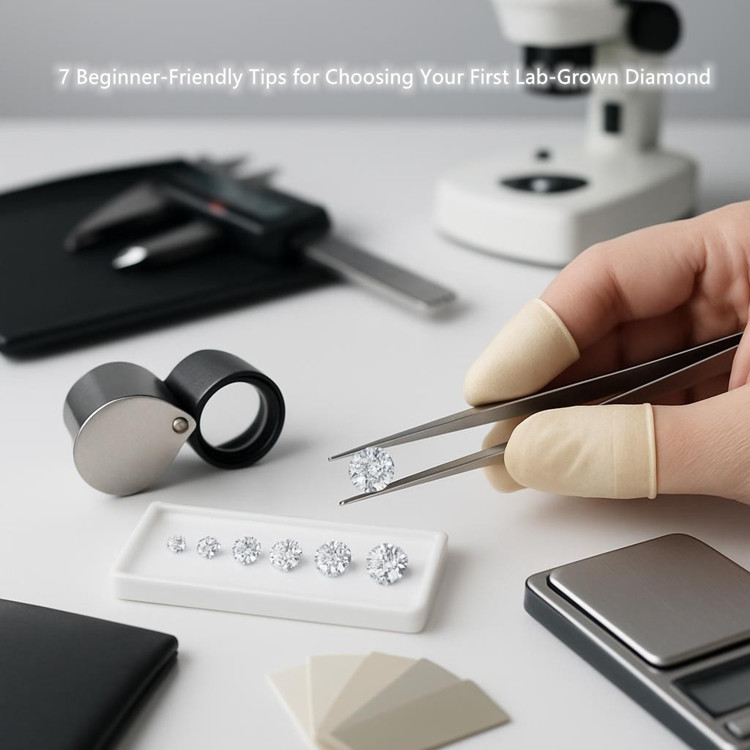
7 Beginner-Friendly Tips for Choosing Your First Lab-Grown Diamond
Introduction
Buying your first lab-grown diamond should feel exciting—not overwhelming. The truth is, lab diamond have made beautiful, well-cut stones more accessible than ever. But with that abundance comes choice: different growth methods, grading labs, price swings, and details that genuinely affect how a diamond looks in real life. If you’re new to this, think of your first lab-grown diamond as your “starter spec”—a smart, confident choice you’ll enjoy now and won’t regret later.
In this guide, I’ll share seven practical, beginner-friendly tips that help you buy with your eyes open. We’ll cover what really matters (and what doesn’t), how to translate technical specs into visual beauty, and how to avoid the few pitfalls that trip up first-time buyers. Angle-wise, we’ll approach this like a product decision: set your success criteria, learn how to read the signal (not the noise), and run a clean, repeatable buying process.
1. Decide what “beautiful” means to you—before you shop
The best way to shop with confidence is to define your taste up front. Many first-time buyers skip this step and end up comparing discounts instead of diamonds. Start with the end in mind:
· Look and vibe: Do you love an icy, white look or a warm, romantic tint? A crisp, brilliant “sparkle” or broad, bold flashes?
· Shape: Rounds are the safest for sparkle and value retention. Ovals, pears, and emeralds feel sleek and elongating on the hand. If you have no shape bias, start with round.
· Size on your hand: Don’t shop carat-only. Look at measurements in millimeters; that’s what your eye sees. On average, a 1.0 ct round is about 6.4–6.5 mm; a 1.5 ct is around 7.3–7.5 mm. Try virtual try-ons or paper cutouts to visualize.
· Ring style: Solitaire for timelessness, halos for bigger presence, bezels for modern minimalism. Style can amplify or tone down a diamond’s look and apparent size.
Do this quick exercise:
· Write 3 must-haves (e.g., round, bright sparkle, minimal bow-tie).
· Write 3 nice-to-haves (e.g., hearts-and-arrows, G color, hidden halo).
· Set a realistic budget range and how firm it is.
2. Learn the 4Cs—then weight them differently for lab-grown diamond
The 4Cs are cut, color, clarity, and carat. For lab diamond, you’ll often get more carat for your budget—so the art is optimizing the other Cs for beauty, not chasing paper perfection.
Cut (priority: highest): Cut drives sparkle, fire, and life. For round brilliants, “Excellent/Ideal” is your starting line, not the finish. Ask for light-performance images (ASET/IdealScope) or hearts-and-arrows photos. Good round parameters to target:
·Table: ~54–58%
·Total depth: ~60–62.3%
·Crown angle: ~34.0–35.0°
·Pavilion angle: ~40.6–40.9°
·Lower girdle facets: ~75–80%
·Girdle: thin–medium–slightly thick, even These are not absolute rules, but they keep you in a safe, beautiful zone.
Color (priority: high, but flexible): The sweet spot for beginners is often G–H for rounds, F–G if you prefer crisp white or are choosing a bezel or yellow gold (which can warm the look). Fancy shapes can show color more; for emeralds/ovals, lean G or better if “icy” is your goal.
Clarity (priority: aim for eye-clean): VS2–SI1 can be excellent value if the stone is eye-clean at 20–30 cm under normal lighting. Ask for magnified videos. Pay attention to inclusion type:
“Clouds not shown” or “Clarity grade based on clouds” may cause haziness—proceed carefully.
HPHT-grown stones can have metallic inclusions; CVD can have graining or pinpoint clusters. These aren’t disqualifiers, just check that the stone looks crisp, not milky.
Feathers near girdle on fancy shapes can affect durability; check placement.
Carat (priority: taste and hand coverage): Use millimeter size to compare. Remember, excellent cut can make a slightly smaller stone look brighter and more lively than a larger, poorly cut one.
3. Understand growth methods and treatments—ask the right questions
lab diamond are real diamonds created by two main methods:
HPHT (High Pressure High Temperature): Grows diamonds under high pressure and temperature, sometimes using metallic catalysts. Colorless HPHT stones can have a cool, steely “white” and occasionally show a subtle blue nuance due to trace boron. Metallic inclusions can occur—ask for close-up videos.
CVD (Chemical Vapor Deposition): Grows diamonds from a gas in layers. Some CVD stones can show brownish undertones from growth; many are post-growth treated (HPHT) to improve color. Watch for strain/graining that could create a faint haze in rare cases.
What to ask your seller:
· Is the diamond HPHT-grown or CVD-grown? Was it post-growth treated?
· Do you see any haze, milkiness, or blue-steel nuance in daylight?
· Are there metallic inclusions (HPHT) or significant graining/clouds (CVD)?
· Can I see magnified videos and light-performance images?
4. Trust the report—but verify with images and proportions
Reliable labs for lab-grown include GIA, IGI, and GCAL. GIA now provides full 4Cs grading for lab diamond. IGI is widely used in the category. GCAL offers light-performance assessments. Avoid no-name labs or reports with vague grades.
How to read the report like a pro:
· Check measurements first (mm), then carat.
· For rounds: review table, depth, crown/pavilion angles, and symmetry/polish grades.
· “Excellent” or “Ideal” varies by lab; pair it with actual images (ASET/IdealScope, hearts-and-arrows if claimed).
· Fluorescence: None to Medium is typically safe. Strong can be fine, but confirm no hazy effect in sunlight.
· Inscription: Ensure the report number is laser-inscribed on the girdle.
For fancy shapes:
· Bow-tie in ovals/pears/marquises is normal to a degree; you’re looking for a lively stone where the bow-tie doesn’t dominate.
· Emerald and Asscher cuts prioritize clarity and transparency; small inclusions can be more visible. Spend a bit more on clarity here.
· ASET images help you avoid dead zones (leakage).
5. Price with a framework—don’t chase the lowest
Lab-grown diamond prices can move. Instead of memorizing numbers, use a transferable framework:
· Compare per-carat prices for similar 4Cs and cut quality. Price = per-carat x carat.
· Expect meaningful premiums for top cut quality, high color (D–F), and high clarity (VVS). Decide if those premiums are visible to you in real life.
· If a price seems too good, check for compromises: haziness, poor light performance, weak polish/symmetry, off-spec angles, or an obscure grading lab.
Allocate your budget:
· 70–85% on the diamond, 15–30% on the setting (varies by design and brand).
· Consider upgrade policies: Many retailers offer lifetime upgrades on lab-grown; read the fine print (often you must spend 1.5–2x).
· Factor insurance for the final piece.
6. Judge with your eyes—videos, lighting, and real-world tests
A certificate can’t show you sparkle. Insist on visual evidence:
· Request 360° videos in mixed lighting: daylight-equivalent, spotlight, ambient. You want contrast (on/off pattern) and lively scintillation.
· Ask for ASET/IdealScope images for rounds and fancy shapes to spot leakage and confirm balance.
· Check for milkiness by viewing the stone against a white background and then on-skin. A crisp diamond stays crisp, not grayish.
· For ovals/pears: compare bow-tie severity. It’s okay if it exists; it shouldn’t dominate.
· Confirm it’s eye-clean for your eyesight and standards, not just a salesperson’s definition.
Pro tip for perception:
· Metal color changes how you perceive diamond color. Yellow/rose gold can make near-colorless stones appear whiter; white metals can reveal true color more. Choose accordingly.
· Settings affect apparent size. Halos/bold bezels boost presence; knife-edge or thin shanks can make the center look larger.
7. Choose a seller who protects you—policies matter
A good vendor makes the process easy and low-risk:
· Transparent listings: Complete specs, grading report PDFs, videos, and images.
· Insured shipping and secure packaging.
· Independent appraisal option.
· Verify the laser inscription matches the report number on delivery.
A safe starter spec (example)
If you want an easy, low-drama starting point for a round brilliant:
· Cut: Ideal/Excellent with supporting images; table 54–58%, depth 60–62.3%, crown 34–35°, pavilion 40.6–40.9°.
· Color: G–H (consider F–G if bezel or if you want extra “icy”).
· Clarity: VS2–SI1, eye-clean; avoid “clouds not shown” notes.
· Fluorescence: None–Medium; Strong only with video proof of no haze.
· Lab: GIA, IGI.
· Growth: CVD as-grown or HPHT colorless with clear videos.
Common pitfalls to avoid
Chasing D/VVS at the expense of cut and light: You’ll pay more for what’s hard to see and less for what’s obvious.
Ignoring videos: A certificate is necessary, but not sufficient.
Over-trusting lab labels: “Excellent” isn’t equal across labs; verify with proportions and images.
Buying fancy shapes without bow-tie checks.
Assuming “eco” always means lower impact: Energy sources vary. If sustainability matters to you, ask for third-party certifications or energy disclosures, not just marketing claims.
Care, insurance, and longevity
·Daily wear safety: Avoid hard knocks; diamonds are hard but can chip at edges.
·Cleaning: Gentle dish soap + soft brush weekly; ultrasonic cleaners only if the setting and stone are secure.
·Insurance: Consider itemized jewelry insurance or add to homeowners/renters with proper documentation.
·Records: Keep your report, invoice, and images together; take photos of inscriptions.
A beginner’s 15-minute shopping workflow
Define: Shape, size range (mm), vibe (icy vs warm), budget.
Shortlist: Filter by lab (GIA/IGI/GCAL), cut tier, and your color/clarity range.
Verify: Pull reports and check proportions; request videos + ASET/IdealScope.
Compare: Watch in multiple lighting; eliminate hazy or leaky stones.
Decide: Choose the one that looks best to you, not the highest on paper.
Protect: Confirm policies, laser inscription, and insurance.
Your first lab-grown diamond doesn’t need to be your final, forever spec—it needs to be a smart choice that delights you now and gives you options later. If you define your taste, prioritize cut and transparency, verify with images, and buy from a seller who stands behind the piece, you’ll end up with a diamond that looks alive on your hand every day. That, more than any letter on a certificate, is what you’ll love.










